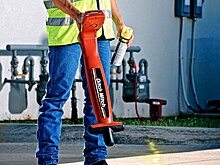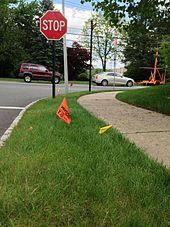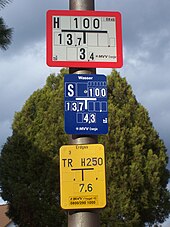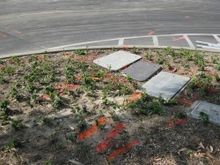This article includes a list of general
references, but it lacks sufficient corresponding
inline citations. (July 2013) |

Utility location is the process of identifying and labeling public utility mains that are underground. These mains may include lines for telecommunication, electricity distribution, natural gas, cable television, fiber optics, traffic lights, street lights, storm drains, water mains, and wastewater pipes. In some locations, major oil and gas pipelines, national defense communication lines, mass transit, rail, and road tunnels also compete for space underground. [1]
Overview
Public utility systems are often run underground—some by the very nature of their function, others for convenience or aesthetics. In the United States, it is estimated that subsurface lines amount to over 20,000,000 miles (32,000,000 km) in total. [2] Before digging, local governments often require that the underground systems' locations be denoted and approved, if it is to be in the public right-of-way.
Pipeline markers, signs, or other indicators may or not be visible to warn of the presence of underground utilities. For various reasons, including security, the precise location of the utilities may not be indicated. The only way an excavator can know the precise location, number, and types of utilities is to contact the underground utilities coordinator, and request that the locations be marked. In most jurisdictions, there is no charge for this service, but advance notification is a legal requirement.
Technology and equipment
Because of the many different types of materials that go into manufacturing each of the different types of underground lines, different detection and location methods must be used. The two general methods are called passive locating and active locating.
Passive locating uses signals that occur naturally on some utility lines. This method often fails to locate 60% or so of utility lines,[ citation needed] and misidentifying utilities is an associated risk. Active locating, on the other hand, is more accurate. It makes use of signals that the locators generate through a transmitter. Then, with the help of a receiver, locators can trace as well as identify what type of utility line lies underground.
The active method is the most suitable for locating conductive metal pipes and cables. This process often involves using a piece of electromagnetic equipment, consisting of a transmitter and a receiver. For other types of pipe such as plastic or concrete, a metallic tracer wire or conductive foil ( detectable tape) may be buried alongside or immediately above the pipe, to aid in locating it. In the absence of such a conductive tracer, other types of radiolocation or modern ground-penetrating radar must be used. Location by these technical means is necessary because maps often lack the pinpoint precision needed to ensure proper clearance. In older cities, it is especially a problem since maps may be very inaccurate, or may be missing entirely.
A few utilities are permanently marked with short posts or bollards, mainly for lines carrying petroleum products. This may be done because of venting requirements, and also serves to indicate the location of underground facilities that are especially hazardous if disturbed.
As of 2022 [update], utility locators depend primarily on three types of utility locating equipment to do their job, including GPR, electromagnetic profiling locators, and radio frequency pipe locators. These tools are produced by a number of manufacturers, and are widely available throughout the world. Some of the large manufacturers include Leica, RIDGID, and Schonstedt. With advances in technology, these tools continue to improve, [3] and locators in the field are able to be more accurate.
Many utilities are now mapped out on GIS mapping services like ESRI, which improves both accuracy and process transparency. Some of the current locate wands are able to relay their information and sync up with GIS systems to expand and correct the information on the map, which helps to update the map very rapidly.
Organizations
In the US, Canada, Australia, and New Zealand, many large locate companies handle millions of tickets every dig season, [4] and need a way of managing these tickets and sending them through to a unified call center (for example, Underground Service Alert).
The Common Ground Alliance (CGA) publishes the Damage Information Reporting Tool (DIRT report) every year, which gives a fuller picture of the effects of utility locating throughout North America. In recent years, DIRT has demonstrated a trend of greater excavation damage incidents over time. [5] This report does not contain every single incident, as stakeholders voluntarily submit underground damages and near-miss reports, but it is the most complete repository of utility damages anywhere in the world. Utility Locators and other stakeholders depend on data like this to learn about risks and to justify continued investment in the industry.
Industry leaders in damage prevention like the Common Ground Alliance and IR-Saving Lives are the biggest promoters of utility locating, and encourage other stakeholders to take utility locating seriously. The CGA also has published a paper called "Insights into Improving the Delivery of Accurate, On-Time Locates",[ citation needed] which has expert information on how to improve the locating industry in the US and Canada (not to be confused with the Canadian Common Ground Alliance (CCGA), a companion organization to CGA in Canada).
Other technologies and equipment are identified in Technology Reports by CGA [6] and in a major study by the Pipeline and Hazardous Materials Safety Administration in 2017 entitled A Study on Improving Damage Prevention Technology. [7]
Telephone hotlines
"Call before you dig", "Know What's Below! Dig With Confidence!", "Dial before you dig", "Digger's Hotline", "One-call", "Miss Utility", "Dig Safe", "Click before you dig", or Underground Service Alert are services that allow construction workers or property owners to contact utility companies, who will then denote where underground utilities are located via color-coded markings typically up to and not past the user's service connection or meter. Utility lines on the other side of the meter or service connection are considered to be part of the customer's property, and will typically not be located by these services.
Failure to call such a number ahead of time may result in a fine or even a criminal charge against a person or company, particularly if such negligence causes a major utility outage or serious accident, or an evacuation due to a gas leak. Hitting a water main may also trigger local flooding or require a boil-water advisory.
The following is a partial list of countries with one-call services for utility location:
- Australia: Australia has a National online website for lodgement of enquiries ( https://www.byda.com.au). The national hotline, 1100, has now been converted to a support line to assist with online lodgement.
- Canada: In Canada, there is no unified number for the country. However, it has the "Click Before You Dig" website that provides access to the hotline for each of the provinces. [8]
- New Zealand: Each utility is responsible for marking its own services. A private company ( https://www.beforeudig.co.nz/) has been contracted by many utilities and city councils to provide one-call services and corridor access requests. A person planning to dig in the public roadway can lodge a ticket with BeforeUDig and have the utilities in the area notified who in turn will respond with maps of their assets.
- United Kingdom: In Scotland there is an online web based service called Vault [9] (short for Scottish Community Apparatus Data Vault), which allows registered users to specify a polygon on a map and immediately obtain an interactive map of all major undertakers owning underground assets, except the principal telecoms operators. In the rest of the UK, there is no dial-before-you-dig service. Instead the onus is on excavators to ensure that they do not damage buried services. [10] This has resulted in a class of locating tools which are simpler to use, and are called Cable Avoidance Tools (CATs), and the associated signal detectors are called Gennys.
- United States: As required by law and assigned by the US Federal Communications Commission (FCC), the 8-1-1 telephone number is used for this purpose across the United States. [11]
Color-coding



Utility color codes are used to identify existing underground utilities in construction areas, to protect them from damage during excavation. Colored lines, flags, or both are used to mark the location and denote the type of underground utility. A special type of spray paint dispenser, which works when the can is upside-down, is used to mark lines, often in a fluorescent color. On flags, a logo often identifies the company or municipal utility which the lines belong to.
Flags may also be an advertisement for a company which has installed an irrigation system for lawns or gardens. In this case, each sprinkler head is usually marked, so that landscaping crews will not cover or bury them with soil or sod, or damage them with tractors or other construction equipment while digging holes for trees, shrubs, or other large plants or fenceposts. This is also important because a vehicle (tractor, truck, or otherwise) can break a sprinkler or the hard- PVC pipe or joint it is mounted on, simply by driving over it, particularly on newly moved soil which is uncompacted and therefore unsupportive of such weight.
Australia
The national standard for Australia uses the following color guide: [12]
Orange electricity Yellow gas Blue water White communications Red fire services Cream sewerage Purple reclaimed water Silver/Gray steam Brown oils, flammable liquids Light blue air Pink Unidentified services Black other liquids
Germany

In Germany, the colors used for temporary marking of underground utilities are not standardized like in other countries. However, permanent marker signs are used for utilities like hydrants, drinking water lines and natural gas lines. A permanent marking of cables and sewage lines is not usual if they run in the public right-of-way. The standard for permanent markers in Germany uses the following colors: [13]
White with red frame fire services (hydrants, suction points etc.) Blue drinking water Yellow gas Green sewage and drain lines Orange or hot water/steam lines for district heating Red White or high-voltage power lines and telecommunication cables Grey Brown lines for oil and other flammable liquids
India
India uses a convention similar to the US, for marking underground utilities such as telephone, gas, water and electricity. The system is based entirely on convention without any written standard. These markings are color-coded, and are painted by contractors onto the pavement. [14]
The main colors based on the convention are used in the same way as in the US: red for electricity, yellow for gas, and blue for water. However, other colors have other meanings. Green is used for telecommunication conduits. White is used as general communication between contractors; white is also used to note the details of road surface markings so that markings can be easily restored after the road construction is completed; a few telecommunication companies also use white color for their utility locations. Orange and other colors are used by local authorities to mark improvements and other details not related to utility locations. [14]
New Zealand
There are no legal color code requirements for buried utilities and surface markings, however a general convention is used and encouraged by the government health and safety department - Worksafe. [15]
Underground Duct Surface Marking Color Surface Marking Letter Utility Orange E Electricity Yellow G Gas Blue Blue W Water White Blue Green Purple T Telecommunications, commonly used by Chorus for copper and fiber optic cables. Light Grey Red SS Waste Water / Sewer Dark Grey Pink SW Storm Water / Drainage Red Regional Utility Specific, commonly used by UFF for fiber optic cables. Purple Regional Utility Specific, known to be used by Telstra Saturn Cable Television Light blue Regional Utility Specific, known to be used by Telstra Clear Pink Regional Utility Specific Black Most commonly used for non-potable water on farms however can be an outer duct for roadside utilities. Worksafe encourages the use of a 5mm wide or larger colored stripe to indicate the content of the black duct using one of the color codes above.
A plain black microduct or 2-pair telephone cable is often used by Chorus for premises drop cables.
United Kingdom
The national standard for the United Kingdom uses the following color guide: [16]
Red electric power lines, conduit, and cables Orange telecommunication, alarm or signal lines Yellow gas, oil, steam, petroleum, or other flammable material Green sewage and drain lines Blue drinking water Purple reclaimed water, irrigation, and slurry lines Pink temporary survey markings, unknown/unidentified facilities White proposed excavation limits or route
United States and Canada

Canada and the United States use the American Public Works Association (APWA) Uniform Color Codes for temporary marking of underground utilities: [17] [18] [19] [20] [21] [22]
Red electric power lines, cables, conduit, and lighting cables Orange telecommunication, alarm or signal lines, cables, or conduit Yellow natural gas, oil, steam, petroleum, or other gaseous or flammable material Green sewers and drain lines Blue drinking water Purple reclaimed water, irrigation, and slurry lines Pink temporary survey markings, unknown/unidentified facilities White proposed excavation limits or route
Some municipalities use pink paint to make lines and codes on the pavements related to required street improvements such as ramp replacement, asphalt grinding, and form injection. These markings are not directly related to utility location. [23]
See also
- Subsurface utility engineering
- Underground Service Alert
- Utility tunnel – an alternative method of routing underground utility lines and services
- Cable locator – an instrument used for detecting the presence and approximate location of buried services
- Utility repair tag – a color-coded tag to identify pavement restorer that sometime has a secondary purpose for utility location
References
- ^ "USDA Utilities". USDA. Retrieved October 5, 2013.
- ^ Energy, Duke. "Before digging, call 811 to avoid striking underground utility lines". Duke Energy | News Center. Retrieved 2022-07-10.
- ^ "The History of Electromagnetic Utility Scanning". www.gp-radar.com. Retrieved 2022-06-30.
- ^ "Locator Spotlight: The Lifecycle of a Locate Request | dp-PRO". dp-pro.com. Retrieved 2022-06-30.
- ^ "2021 DIRT Report". dirt.commongroundalliance.com. Retrieved 2022-11-14.
- ^ "Technology Reports". commongroundalliance.com. Retrieved 2022-07-10.
- ^ "Report to Congress on Improving Damage Prevention Technology | PHMSA". www.phmsa.dot.gov. Retrieved 2022-07-10.
- ^ "Click Before You Dig". Canadian One-Call Centres Committee and the Canadian Common Ground Alliance. Retrieved 21 October 2014.
- ^ "Vault". www.roadworksscotland.gov.uk. Retrieved 2017-11-10.
- ^ "Avoiding danger from underground services". Health and Safety Executive (UK). Retrieved 24 April 2017.
- ^ "811. Know what's below. Call before you dig". call811.com. Common Ground Alliance. Retrieved 2013-07-24.
- ^ "Dial before you dig - Working near power cables" (PDF). Energex. Retrieved 1 February 2018.
- ^ "Was bedeuten die kleinen Schilder an Häusern?" (in German). t-online.de. 9 June 2021. Retrieved 20 February 2022.
- ^ a b Cawley, Laurence (2014-02-18). "What do those squiggles on the pavement actually mean?". BBC News. Retrieved 19 February 2014.
- ^ "Guide for Safety with Underground Services - Page 29". Retrieved 27 November 2021.
- ^ "UNDERGROUND UTILITY COLOUR CODES EXPLAINED". Cornerstone Projects Ltd. Retrieved 25 July 2019.
- ^ "APWA Uniform Color Code" (PDF). American Public Works Association. Retrieved 7 May 2014.
- ^ "How Do I Interpret Locate Markings/ Documentation?". Dig Safe (Ontario). Retrieved 21 October 2014.
- ^ "FORMS AND SAFETY TIPS". BC One Call. Retrieved 21 October 2014.
- ^ "Colour code". Info-Excavation (Quebec). Retrieved 21 October 2014.
- ^ "Color Code Explanation". Alberta One–Call. Retrieved 21 October 2014.
- ^ "COLORS | Underground utility markings and colors". Competers Inc. 2022-01-10. Retrieved 2022-06-30.
- ^ "Street Marking Explanations". City of Fort Collins. Retrieved 9 May 2014.
- Technology Transfer Information Center. "Statement of Need: Utility Locating Technologies". Accessed October 31, 2007.
- Jaufer, Rakeeb M., Amine Ihamouten, Yann Goyat, Shreedhar S. Todkar, David Guilbert, Ali Assaf, and Xavier Dérobert. 2022. "A Preliminary Numerical Study to Compare the Physical Method and Machine Learning Methods Applied to GPR Data for Underground Utility Network Characterization" Remote Sensing 14, no. 4: 1047. https://doi.org/10.3390/rs14041047
External links
- American Public Works Association, an organization of public works professionals
- National Utility Locating Contractors Association, a utility locating organization